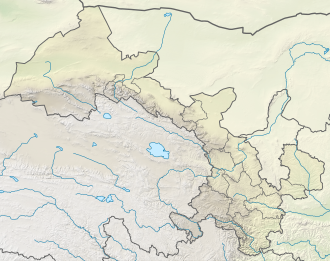Crescent Lake (Dunhuang)
This article needs additional citations for verification. (May 2013) |
| Yueyaquan | |
|---|---|
| Crescent Lake | |
| 月牙泉 (Chinese) | |
 The lake and pavilion in 2023 | |
| Location | Gansu |
| Coordinates | 40°5′12″N 94°40′10″E / 40.08667°N 94.66944°E |
| Basin countries | China |
| Surface area | 1.37 acres (0.55 ha) |
| Average depth | 4–5 m (1960) 0.9 m (1990s) |
| Max. depth | 7.5 m (1960) 1.3 m (1990s) |
Yueyaquan (
History
The lake was named Yueyaquan in the
According to measurements made in 1960, the average depth of the lake was 4 to 5 metres (13 to 16 ft), with a maximum depth of 7.5 metres (25 ft). In the following 40 years, the depth of the lake declined by more than 7.6 metres (25 ft).[2] In the early 1990s, it had shrunk to an average depth of one meter. In 2006, the local government with help of the central government started to fill the lake and restore its depth; its depth and size have been growing yearly since then.[3] Proposed groundwater diversions are modeled to raise the water table and level of the lake.[4]
Tourism
The lake and the surrounding deserts are very popular with tourists, who are sand sledding, offered camel tours, all-terrain vehicle rides, helicopter tours and motor glides.[5][6] Crescent Lake got part of the Dunhuang Yardang National Geopark which was recognized 2015 by UNESCO.[7]
External links
- Tourists Information (Japanese / English / Korean)
References
- ^ Cable, Mildred; French, Francesca (1950). The Gobi Desert. London: Readers Union & Hodder and Stoughton. p. 63.
- ^ Yardley, Jim (27 May 2005). "A Crescent of Water is Slowly Sinking into the Desert". The New York Times.
- Independent.co.uk. 15 May 2013.
- S2CID 134958513.
- ^ "In China's Land of Buddhas and Fortresses, Kindness Prevails". The New York Times. November 27, 2018.
- ^ "鸣沙山月牙泉游玩项目" [Playing at the Moon Spring of Mingsha Mountain] (in Chinese). Retrieved 2024-11-05.
- ^ "Nine new sites added to Global Geoparks Network". UNESCO. 2015-09-21. Retrieved 2024-11-05.


